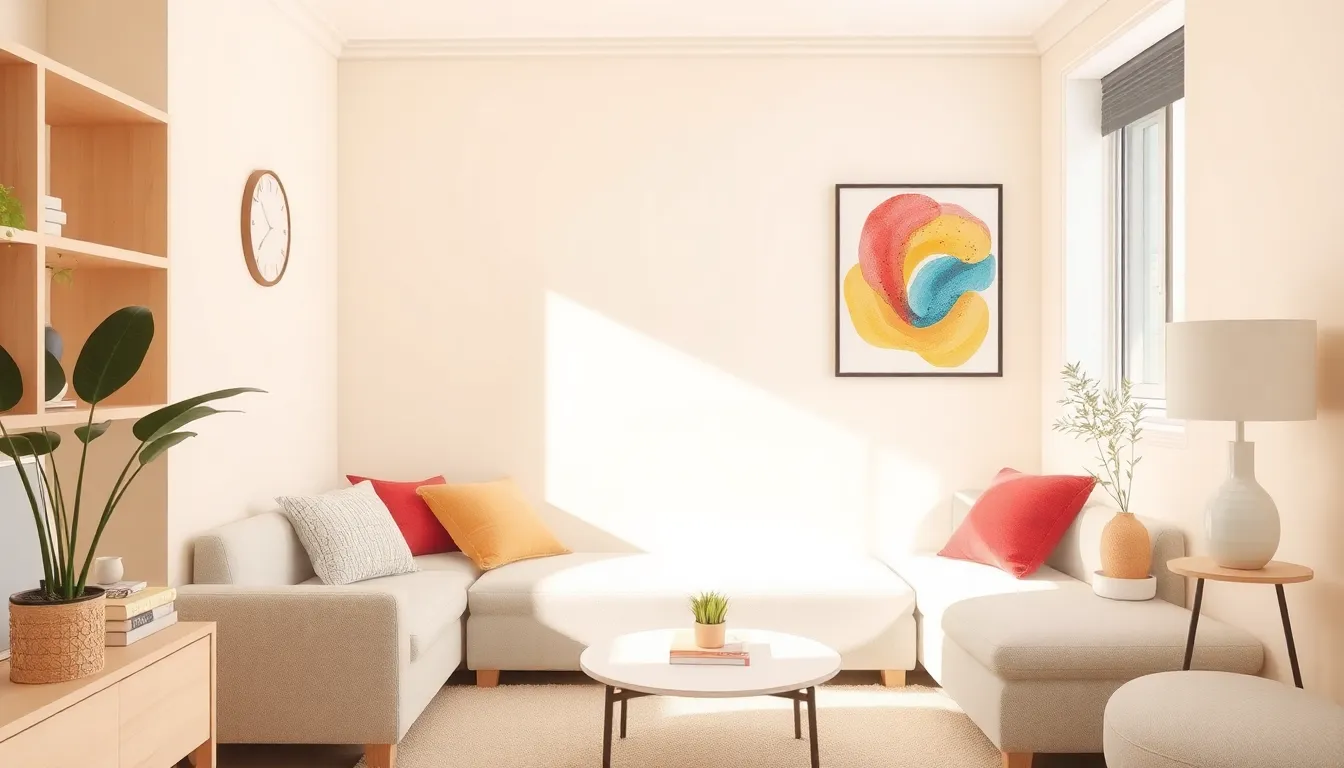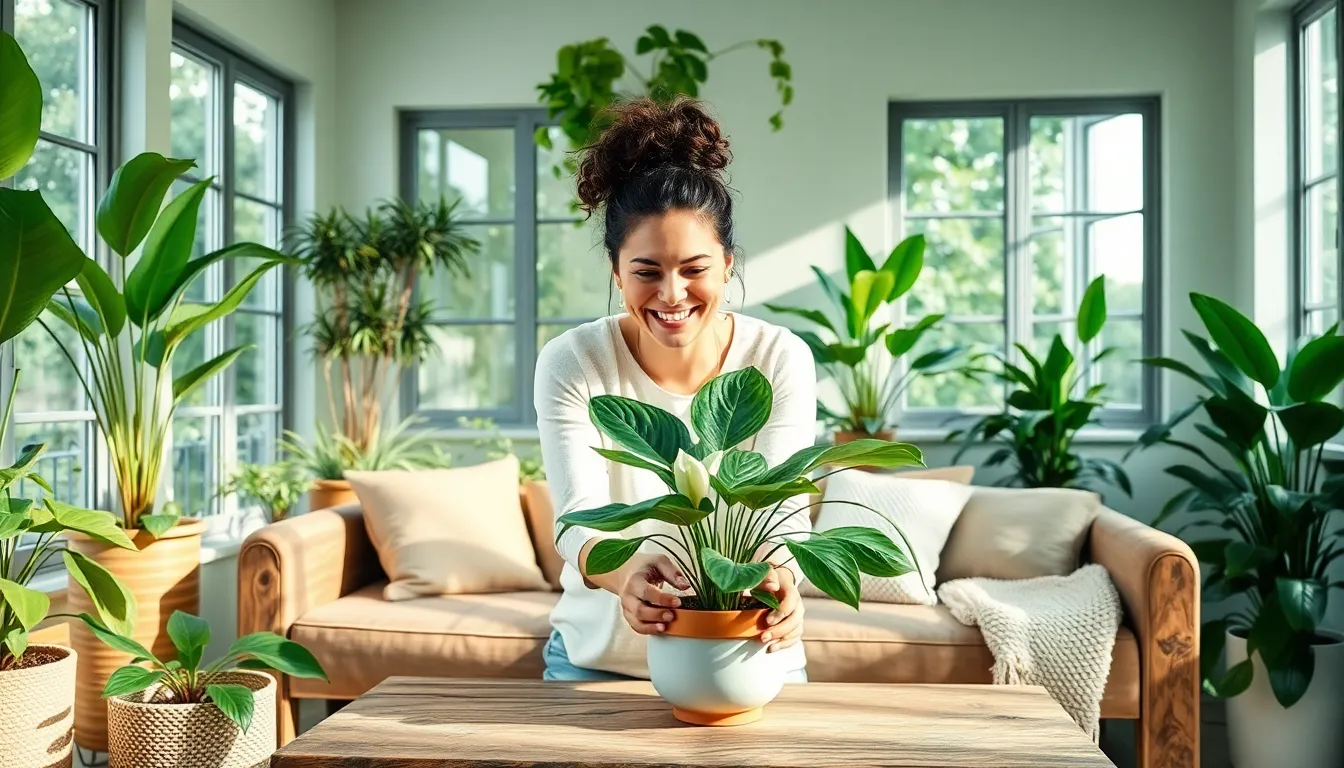In a world where space is often at a premium, small rooms can feel like a design challenge straight out of a reality show. But fear not! With a sprinkle of creativity and a dash of clever planning, transforming a tiny space into a stylish sanctuary is entirely possible. Think of it as a fun puzzle where every piece counts, and the end result is a cozy haven that maximizes both style and functionality.
Table of Contents
ToggleUnderstanding Small Room Interior Design Ideas
Small room interior design focuses on creativity and strategic use of space. When done right, even a tiny area can appear spacious and inviting.
Importance of Maximizing Space
Maximizing space is crucial in small room design. It enhances functionality without sacrificing comfort. Employ multi-functional furniture to increase utility, such as sofa beds or storage ottomans. Consider vertical storage solutions like shelves and cabinets that utilize wall space. Planning helps avoid overcrowding; maintain pathways and ensures ease of movement. Use mirrors to create the illusion of depth, making a room appear larger. Soft color palettes also play a role; lighter shades reflect light, contributing to an airy feel.
Maintaining Aesthetic Appeal
Aesthetic appeal is essential, even in limited spaces. Cohesion in colors and materials provides a polished look. Integrate decorative elements that express personal style, keeping them proportional to the room’s size. Artwork and decorative accents can add character without overwhelming the space. Layering textures creates visual interest; combine textiles like rugs, cushions, and throws. Plants can infuse life into a small area, bringing freshness and color. Thoughtful lighting is vital, too; employ ambient, task, and accent lighting to enhance atmosphere while maintaining elegance.
Color Schemes for Small Rooms

Color plays a vital role in small room design. It influences perception and mood, making it essential to choose the right hues wisely.
Light vs. Dark Colors
Light colors enhance the sense of space in small rooms. Shades like white, soft beige, and pale pastels can open up a room and reflect light. In contrast, dark colors may create a cozy atmosphere but can make a room feel smaller. Dark hues like navy or charcoal can add depth when used strategically, perhaps on an accent wall. Balancing light and dark tones can also help define areas within open spaces.
Using Accent Colors Effectively
Accent colors add personality to small rooms without overwhelming them. One or two bold colors can serve as focal points. They work well in accessories, artwork, or decorative items. For instance, a bright throw pillow or a vibrant piece of art can draw attention and create visual interest. When employing accent colors, keeping the surrounding palette neutral ensures the space remains airy and open. Use accents sparingly, allowing them to stand out while maintaining harmony with the overall design.
Furniture Selection and Layout
Selecting the right furniture and layout is vital in small room design. Thoughtful choices create a harmonious and functional environment.
Multi-Functional Furniture
Multi-functional furniture maximizes usability. Consider a sofa bed that converts into a sleeping space, ideal for accommodating guests. Ottomans that provide storage keep clutter at bay. Use dining tables that expand to serve multiple purposes, offering extra room during gatherings. Nesting tables serve as flexible surfaces, easily moved as needed. Select furniture that fits well without overpowering the space, maintaining an open feel.
Space-Saving Layout Techniques
Space-saving layout techniques enhance flow and functionality. Position furniture along walls to free up floor space, allowing for greater movement. Utilize corner areas with clever shelving for added storage and display. Arrange furniture in a way that promotes conversation, using circular seating to encourage interaction. Vertical arrangements draw the eye upward, making the room feel taller. Keep pathways clear for accessibility, supporting an inviting atmosphere without clutter.
Lighting Solutions for Small Spaces
Lighting plays a pivotal role in enhancing small spaces, contributing to their overall atmosphere and functionality. Thoughtful illumination can transform a cramped room into a welcoming retreat.
Natural Light Enhancement
Maximizing natural light significantly improves the ambiance of small rooms. Use sheer curtains to allow sunlight to filter through while maintaining privacy. Position mirrors across from windows to reflect light, creating a sense of openness. Consider removing heavy window treatments to avoid blocking daylight, as this brings brightness into the room. Keep the window area uncluttered to let light flow freely, fostering an airy environment. Incorporate light-colored walls to amplify the effect of incoming sunlight, further enhancing the sense of space.
Choosing the Right Fixtures
Selecting appropriate lighting fixtures is crucial for optimizing small spaces. Opt for wall-mounted sconces that save floor space while providing sufficient illumination. Pendant lights can add visual interest, especially over dining areas or kitchen islands, without consuming valuable space. Use recessed lighting to maintain a clean ceiling line, ensuring a streamlined look. Layer different types of lighting, including task and ambient, to create a versatile lighting scheme that adapts to various needs. Focus on fixtures with a sleek profile to avoid overwhelming the area, contributing to a more open feel.
Decor and Accessories
Decor and accessories play a crucial role in small room design, enhancing both functionality and style. Carefully chosen elements can create a harmonious environment while maximizing space.
Minimalist Decor Tips
Minimalist decor offers elegance and simplicity. Focus on selecting a few key pieces that reflect personal style without overcrowding a room. Incorporate empty spaces for balance, allowing each element to breathe. Natural materials and neutral colors contribute to a calming atmosphere. Consider wall art that complements the room’s color scheme. Succinct lines in furniture help maintain an uncluttered look. Incorporate one or two statement accessories, such as a bold vase or sculptural piece, to create visual interest in a subtle manner.
Smart Storage Solutions
Smart storage solutions utilize every inch of available space effectively. Install floating shelves to hold books or decorative items without taking up floor space. Use under-bed storage containers for items not frequently used, keeping them out of sight but easily accessible. In addition, furniture with built-in storage, like benches or coffee tables with compartments, enhances organization while maintaining a clean appearance. Consider using decorative baskets for open shelving, adding texture while helping to corral smaller items. Maximizing vertical space through high shelving helps draw the eye upward, creating an illusion of a larger area.
Transforming a small room into a stylish and functional space is entirely achievable with the right approach. By embracing creative solutions and smart design choices, anyone can maximize their limited square footage. Utilizing multi-functional furniture and strategic layouts not only enhances usability but also fosters an inviting atmosphere.
Incorporating light colors and thoughtful lighting can significantly impact how a space feels. By balancing decor with functionality and selecting key pieces that reflect personal style, small rooms can exude charm without feeling cluttered. With these tips in mind, it’s possible to create a cozy retreat that feels both spacious and welcoming.







